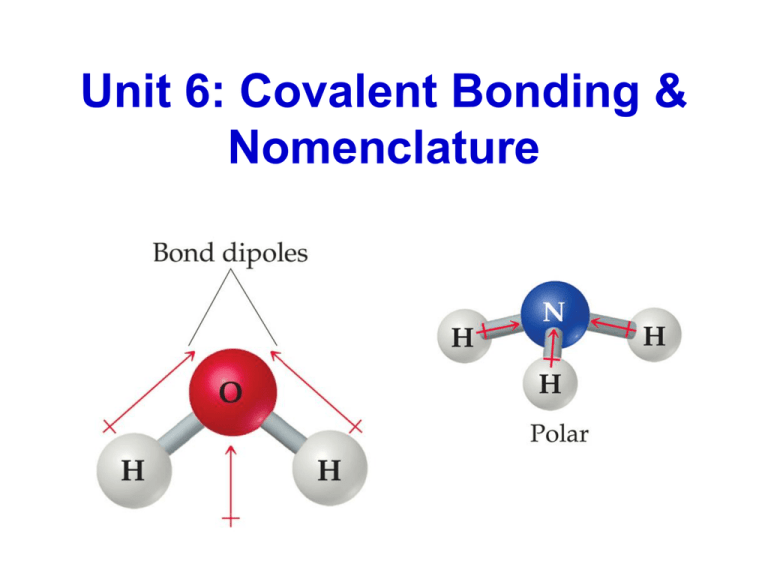Covalent Bonding - Chemistry 1 at NSBHS
advertisement

Unit 6: Covalent Bonding & Nomenclature Section 1: Covalent Bonding & Lewis Structures These toy models are made from circular pieces joined together in units by sticks. Atoms can also be arranged in different ways to make a variety of products. 8.1 covalent bond – formed by sharing e-’s between atoms. (nonmetals only) molecule – neutral group of atoms joined by covalent bonds. molecular compound – composed of molecules with covalent bonds. 8.1 diatomic molecule – molecule consisting of two atoms of the same element. Memorize these!! 8.1 molecular formula: shows how many atoms of each element a molecule contains. 8.1 Properties of molecular compounds: lower melting and boiling points than ionic compounds. (usually liquid or gas) poor conductors 8.2 Octet Rule: atoms tend to combine to have 8 electrons in their outer shell like noble gases. 8.2 lone pair unshared pair nonbonded pair 1 shared pair single bond: atoms bonded by sharing a pair of electrons. 8.2Covalent Bonds Single How many unshared pairs? 8.2 Single Covalent Bonds How many shared pairs? 8.2 Double and Triple Covalent Bonds double bond: bond that shares two pairs of electrons. O O triple bond: bond that shares three pairs of electrons. N N 8.2 HONORS Super Special Carbon Carbon can form long chains because it forms up to 4 bonds on each carbon atom. Without this property, large biomolecules could not form such as: proteins lipids (fats) carbohydrates (sugars/starches) nucleic acids (DNA/RNA) Writing Lewis Structures PCl3 5 + 3(7) = 26 1. Add valence electrons of all atoms. Writing Lewis Structures 2. Central atom is the least electronegative. (to the left in PT) Connect all single bonds. Keep track of the electrons: 26 6 = 20 Writing Lewis Structures 3. Fill the octets of the outer atoms. Keep track of the electrons: 26 6 = 20 18 = 2 Writing Lewis Structures 4. Fill the octet of the central atom. Keep track of the electrons: 26 6 = 20 18 = 2 2 = 0 Writing Lewis Structures 5. If you run out of electrons before the central atom has an octet… …form multiple bonds until it does. 8.1 Section Assessment Draw the Lewis structure for trichloromethane, CHCl3 Draw the Lewis structure for carbon dioxide, CO2 O C O Quick Quiz! 1. A molecular compound usually consists of A. two metal atoms and a nonmetal atom. B. two nonmetal atoms and a metal atom. C. two or more metal atoms. D. two or more nonmetal atoms. Quick Quiz. 2. A molecular formula shows A. how many atoms of each element a molecule contains. B. a molecule's structure. C. which atoms are bonded together. D. how atoms are arranged in space. Quick Quiz. 3. Compared to ionic compounds, molecular compounds tend to have relatively A. low melting points and high boiling points. B. low melting points and low boiling points. C. high melting points and high boiling points. D. high melting points and low boiling points. Quick Quiz. 4. In covalent bonding, atoms attain an octet electron configuration like noble gases by A. losing electrons. B. gaining electrons. C. transferring electrons. D. sharing electrons. Quick Quiz. 5. Carbon atoms have 4 valence electrons to form up to 4 bonds. This allows carbon to form _________________ needed for life. A. large, long chain biomolecules. B. nucleic acids C. carbohydrates D. all of the above Quick Quiz. 6. Which of the following diatomic molecules have a triple bond? (hint: draw the Lewis structures) A. O2 O O B. N2 N N C. Br2 Br Br D. H2 H H Quick Quiz. 7. Draw the correct Lewis structure for nitrous oxide (or laughing gas), N2O. hint: arrange the atoms as… N N O N N O





